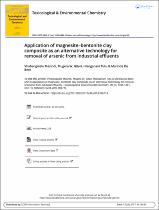 ResearchSpace
ResearchSpace
Application of magnesite–bentonite clay composite as an alternative technology for removal of arsenic from industrial effluents
JavaScript is disabled for your browser. Some features of this site may not work without it.
- ResearchSpace
- →
- Research Publications/Outputs
- →
- Journal Articles
- →
- View Item
| dc.contributor.author |
Masindi, Vhahangwele

|
|
| dc.contributor.author |
Gitari, MW

|
|
| dc.contributor.author |
Tutu, H

|
|
| dc.contributor.author |
De Beer, Marinda

|
|
| dc.date.accessioned | 2017-07-28T09:37:13Z | |
| dc.date.available | 2017-07-28T09:37:13Z | |
| dc.date.issued | 2014-10 | |
| dc.identifier.citation | Masindi, V., Gitari, M.W., Tutu, H. and De Beer, M. 2014. Application of magnesite–bentonite clay composite as an alternative technology for removal of arsenic from industrial effluents. Toxicological & Environmental Chemistry, 96(10), pp 1435-1451. doi.org/10.1080/02772248.2014.966714 | en_US |
| dc.identifier.issn | 0277-2248 | |
| dc.identifier.uri | http://www.tandfonline.com/doi/abs/10.1080/02772248.2014.966714 | |
| dc.identifier.uri | http://hdl.handle.net/10204/9410 | |
| dc.description | Copyright: 2014 Taylor & Francis | en_US |
| dc.description.abstract | This study evaluated the feasibility of integrating amorphous magnesite and bentonite clay (composite) as an alternative technology for removing arsenic from industrial effluents. The removal of arsenic from industrial effluents by using magnesite–bentonite clay composite was carried out in batch mode. The effects of equilibration time, adsorbent dosage, adsorbate concentration, and pH on removal of arsenic were investigated. The experiments demonstrated that ≈100% arsenic removal is optimum at 30 minutes of agitation, 2 g of adsorbent dosage (2 g: 100 mL, S/L ratio), and 20 mg L−1 of arsenic concentration. The adsorption data fitted well to both Langmuir and Freundlich adsorption models, hence proving monolayer and multilayer adsorption. The kinetic studies revealed that the data fitted better to a pseudo-second-order reaction than to a pseudo-first-order reaction, hence proving chemisorption. At optimized conditions, the composite was able to remove arsenic to below World Health Organization water quality guidelines, hence depicting that the composite is effective and efficient in removing arsenic from contaminated water. Based on that, this comparative study proves that the composite is a promising adsorbent with high adsorption capacity for arsenic and can be a suitable substitute for the conventional treatment methods. | en_US |
| dc.language.iso | en | en_US |
| dc.publisher | Taylor & Francis | en_US |
| dc.relation.ispartofseries | Workflow;19171 | |
| dc.subject | Wastewater | en_US |
| dc.subject | Arsenic | en_US |
| dc.subject | Magnesite | en_US |
| dc.subject | Bentonite clay | en_US |
| dc.subject | Composites | en_US |
| dc.title | Application of magnesite–bentonite clay composite as an alternative technology for removal of arsenic from industrial effluents | en_US |
| dc.type | Article | en_US |
| dc.identifier.apacitation | Masindi, V., Gitari, M., Tutu, H., & De Beer, M. (2014). Application of magnesite–bentonite clay composite as an alternative technology for removal of arsenic from industrial effluents. http://hdl.handle.net/10204/9410 | en_ZA |
| dc.identifier.chicagocitation | Masindi, Vhahangwele, MW Gitari, H Tutu, and Marinda De Beer "Application of magnesite–bentonite clay composite as an alternative technology for removal of arsenic from industrial effluents." (2014) http://hdl.handle.net/10204/9410 | en_ZA |
| dc.identifier.vancouvercitation | Masindi V, Gitari M, Tutu H, De Beer M. Application of magnesite–bentonite clay composite as an alternative technology for removal of arsenic from industrial effluents. 2014; http://hdl.handle.net/10204/9410. | en_ZA |
| dc.identifier.ris | TY - Article AU - Masindi, Vhahangwele AU - Gitari, MW AU - Tutu, H AU - De Beer, Marinda AB - This study evaluated the feasibility of integrating amorphous magnesite and bentonite clay (composite) as an alternative technology for removing arsenic from industrial effluents. The removal of arsenic from industrial effluents by using magnesite–bentonite clay composite was carried out in batch mode. The effects of equilibration time, adsorbent dosage, adsorbate concentration, and pH on removal of arsenic were investigated. The experiments demonstrated that ≈100% arsenic removal is optimum at 30 minutes of agitation, 2 g of adsorbent dosage (2 g: 100 mL, S/L ratio), and 20 mg L−1 of arsenic concentration. The adsorption data fitted well to both Langmuir and Freundlich adsorption models, hence proving monolayer and multilayer adsorption. The kinetic studies revealed that the data fitted better to a pseudo-second-order reaction than to a pseudo-first-order reaction, hence proving chemisorption. At optimized conditions, the composite was able to remove arsenic to below World Health Organization water quality guidelines, hence depicting that the composite is effective and efficient in removing arsenic from contaminated water. Based on that, this comparative study proves that the composite is a promising adsorbent with high adsorption capacity for arsenic and can be a suitable substitute for the conventional treatment methods. DA - 2014-10 DB - ResearchSpace DP - CSIR KW - Wastewater KW - Arsenic KW - Magnesite KW - Bentonite clay KW - Composites LK - https://researchspace.csir.co.za PY - 2014 SM - 0277-2248 T1 - Application of magnesite–bentonite clay composite as an alternative technology for removal of arsenic from industrial effluents TI - Application of magnesite–bentonite clay composite as an alternative technology for removal of arsenic from industrial effluents UR - http://hdl.handle.net/10204/9410 ER - | en_ZA |





